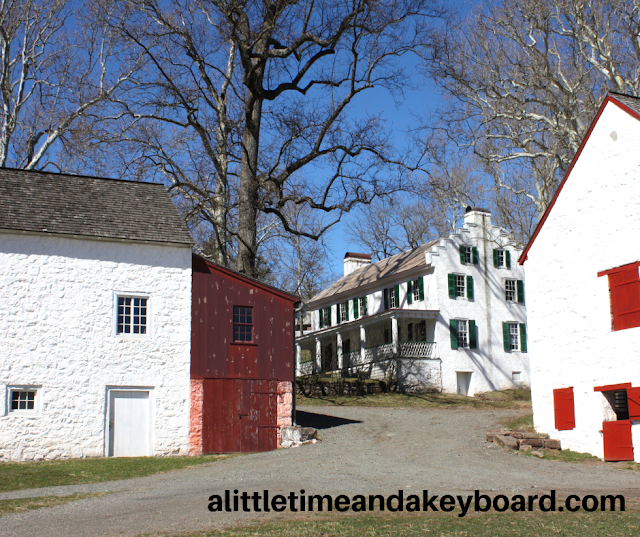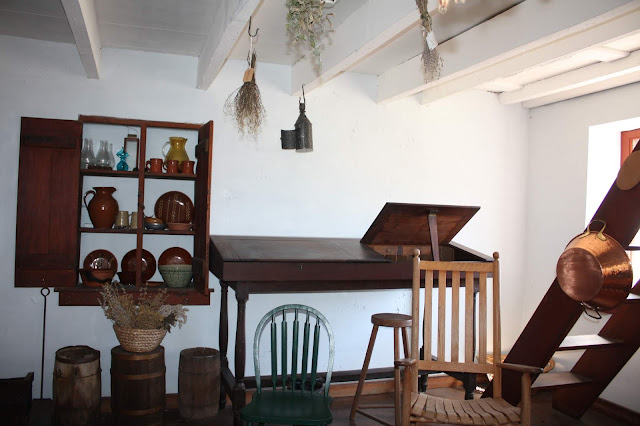Investigating Early Industry at Hopewell Furnace National Historic Site in Pennsylvania
Hopewell Furnace National Historic Site in Elverson, Pennsylvania provided our family with an afternoon learning about early industry in the United States set inside a scenic nature preserve. When we visited my family in Pennsylvania, we savored beautiful spring weather and went on an exploration of the historic site.
Artifacts and Hands-on Learning in the Visitor Center:
The best way to orient yourself for exploring Hopewell Furnace is a stop in the Visitor Center. While not huge, there are a healthy number of displays discussing the history of Hopewell Furnace during its time of operation from 1771-1883.
 |
| Iron stoves manufactures at Hopewell Furnace. |
 |
| Hands-on discovery table introducing iron production and village life. |
 |
| Antique sewing kit used by the furnace owner's daughter. |
I also love the protective shoes to help protect workman's shoes from fire and molten metal. A number of displays like this lay out interesting facts and artifacts.
Before leaving the Visitor Center, don't forget to grab some maps, informational pamphlets, ask questions and inquire about the Junior Ranger program if you have little ones. There also is a short video to watch as well.
 |
| Exploring an early industrial village at Hopewell Furnace. |
Hopewell Furnace National Historic Site includes structures involved in the industrial process. as well as the ironmaster's house, workers' homes a general store, storehouse schoolhouse ruins and more. Workers and their families lived near their place of employment -- the furnace -- and thus a village developed. We were not expecting to see farm animals during our visit but actually were greeted by a herd of sheep running home much to the delight of adults and children alike.
 |
| Sheep herd coming home! |
 |
| Remains of the anthracite furnace |
A peek at the furnace where pig iron was forged:
 |
| Pig iron was forged in this furnace. |
 |
| 22-Diameter Water Wheel powered the air blast needed to heat the furnace. |
Another favorite spot for me was the office and general store. I loved having peeks into the village life of the site.
 |
| Office and store |
Hopewell Furnace National Historic Site rewarded us with a educational and interesting family adventure while allowing us time to enjoy nature and a beautiful spring day. The entire site is beautiful and just asking for a stroll through. The site is worth a visit whether you are interested in industrial history, early American history or just to savor some time outside.
Some Facts About Hopewell Furnace:
- During the Revolutionary War, the furnace produced iron cannons, shot and shell.
- Iron ore came from three different area mines.
- The builder of the furnace owned slaves. Slaves are believed to have worked on construction of Hopewell Furnace. Slaves were emancipated in Pennsylvania in 1780. African Americans continued to work at Hopewell Furnace throughout its history.
- Hopewell Furnace and its surrounding woods were part of the Underground Railroad. Many former slaves also worked at the furnace.
- Women worked in a variety of capacities including selling food items, washing and mending clothing and more. A few worked in an industrial capacity or in the mines and earned the same amount as the men.
Helpful Tips:
- Inside the Visitor Center is a gift shop. In addition to gifts, there are a few snacks available for purchase.
- You can pick apples from the orchard in the fall, see website for more info.
- Hopewell Furnace is surrounded by French Creek State Park. So, there are plenty of trails available.
- Interpreters are available during warmer months. See the website for more information and details on the schedule.
**Disclosure: No compensation was received for this post. All opinions are 100% my own.







What a fascinating place with so much history!
ReplyDeleteMy uncle, James Cass, was curator there when my parents visited in 1952 ! I found an old photo of them standing in front.
ReplyDelete